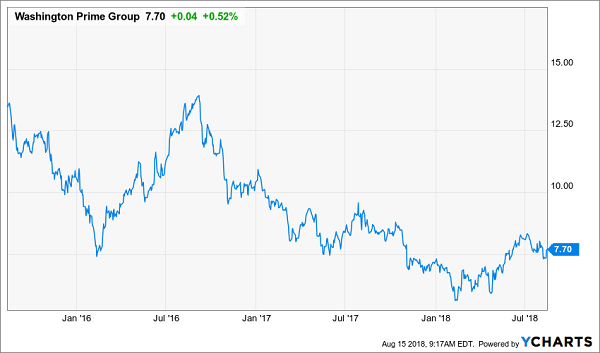Individual investors tend to gravitate toward stocks trading under $10 for multiple reasons. For one, it can psychologically feel more powerful to buy 100 shares of a company trading for $8 than just eight shares of a $100 name.
While both investments are just as likely to generate attractive returns over time, low-dollar stocks have historically proven to be more volatile. In other words, they can offer active traders more bang for their buck in the short term.
Volatility works both ways, which is why I’ve highlighted two stocks that appear to be trading under $10 for a reason and might not be able to sustain their current dividends. Potential value traps come in all shapes and sizes.
Disastrous Dividend Stock Under $10 No. 1: No Money, Mo’ Problems

Barnes & Noble (BKS) is a retailer that’s more than a decade removed from its heyday, but still might tempt some investors as a familiar name with a juicy 9.5% dividend yield. However, the company fails the first test of dividend investing—it doesn’t generate enough profit to cover the quarterly payout of $0.15 a share.
In fact, Barnes and Noble has not covered its dividend since management reinitiated the payout in 2015. If a company is lucky, it can borrow money or find other ways to cover a dividend for a year or two, but the retailer has been robbing Peter to pay Paul for too long already.
It’s not simply an issue of people not buying books anymore, or that Amazon continues to smother the company, as Barnes & Noble generated $3.7 billion of revenue from over 600 stores in fiscal 2018 (ended April). The problem is that the retailer still lost money on that level of sales last year.
Management had initiated a significant restructuring effort in March to cut costs, but that strategy hit a significant speed bump in July, when chief executive officer Demos Parneros was abruptly fired for violating company policy.
The company ended the most recent quarter with just $10 million of cash and $158 million of debt. Whomever the next CEO is will likely find it increasingly difficult to scrounge up $42 million to cover the dividend for another year.
Disastrous Dividend Stock Under $10 No. 2: High Debt and Not-so Prime Assets

Washington Prime (WPG) is a real estate investment trust (REIT) with investments in over 100 shopping centers. The company was spun out of Simon Property (SPG) in 2014 and merged with Glimcher Realty Trust a year later to create the current entity.
Simon is the premier retail REIT in the market, but the parent company held onto its top assets and primarily placed second- and third-tier malls into Washington Prime. The difference can be seen in the performance of the two stocks since the spin, but also in the declining profits of Washington Prime, which might not support its 25-cent quarterly dividend (13% yield).
Management recently reiterated its 2018 funds from operations guidance of $1.48 to $1.56 a share. This should cover the dividend for the time being, but does not give the company much leeway, especially as revenue is steadily declining along with the mall retail business.
Washington Prime’s bonds carry a BBB- rating, which is the final stage before reaching junk status. The company has a 71% debt-to-capital ratio and the bondholders always get their interest before the dividend is paid. With a deteriorating financial outlook management may soon be faced with sacrificing the dividend to keep the bondholders happy.
My previous experience is that most dividend stocks under $10 are cheap for a reason and artificially high yields are likely too good to be true. Active traders can afford to speculate in this area, but buying lottery tickets is not a good way to build wealth and retire early. If you’re not careful, small stocks can still cause big damage to your portfolio.
If, however, you’re nearing retirement, or have already retired and are living off income from your investments, I strongly encourage you to check out the top 7 REITs from Brett Owens, Contrarian Outlook’s Chief Investment Strategist. All seven are key recommendations in his 8% No Withdrawal Portfolio and check both boxes for “dividend growth” and “high current yield”.
As a group, they pay an impressive 8.5% average yield today, which is downright outstanding in a 3% world.
Combine 5% to 10%+ dividend growth with these high-single-digit current yields, and we have a formula for safe 15% to 20%+ annual gains from REITs, with a significant portion of that coming as cash dividends.
And thanks to the new tax plan, there’s never been a better time to buy REITs and live off their dividends.
(REIT investors will benefit from the tax breaks that “pass through” businesses will receive in the new code. Investors will be allowed deduct 20% of their REIT dividend income, which means the 37% tax bill will drop to 29.6%.)
But it’s important to choose your REITs wisely.
Don’t buy a low-yielding static payer. Don’t buy a retail REIT, either (with that entire industry in a death spiral, future rent checks will be dicey for years to come).
Instead, focus on recession-proof firms, such as those that rent hospitals, business lodging and warehouses filled with Amazon packages. Landlords that own properties that will be in high demand no matter what happens to interest rates or the economy from here, in other words.
We’d love to share Brett’s seven favorite recession-and-rate-proof REITs with you – including specific stock names, tickers and buy prices. Click here and I’ll send my full 8% No Withdrawal Portfolio research you to right now.
